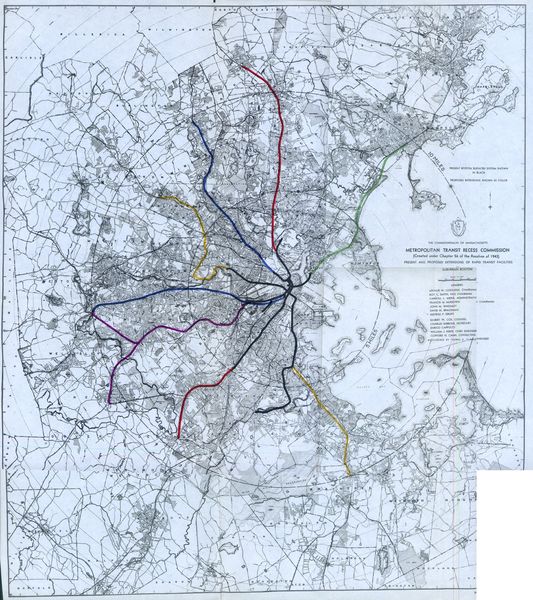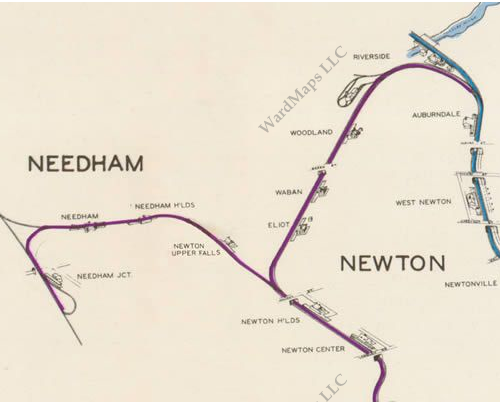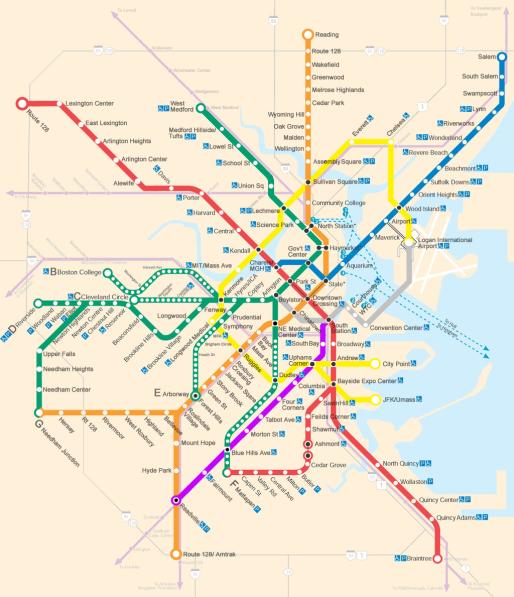Re: North-South Rail Link
https://usa.streetsblog.org/2018/11/23/u-s-finally-legalizes-modern-european-style-train-cars/
I don't think I've seen any discussion of this new FRA decision? I wonder if anyone thinks this would impact the costs for regional rail/NSRL and by how much.
None for NSRL because the dimensions of the tunnel are set by the very limited allowances where you can dig without fouling any surrounding infrastructure. That means depth underground is what it is, and so are the grades because there's extremely limited placements for the portals (example: the NEC portal can *only* get plunked in a roughly 500 ft. span east of the Shawmut Ave. overpass, west of the Harrison Ave. overpass, and more or less centered on the Washington St. overpass...lest it foul the Orange Line tunnel to the west or surface Cove Interlocking to the east). Speeds also wouldn't change underground with lighter rolling stock because of the tight confines of the interlockings.
The tunnel will be built with allowances to take anything as light as a space-age EMU, or as heavy as a six-pack of Kawasaki bi-levels hauled by a porky dual-mode loco. Performance specs of rolling stock inform the
systemwide ops practices you can run...which is why an EMU universe is so much better than the push-pull universe the state's flawed study was based on. But that rolling stock decision doesn't inform any steel-and-concrete tunnel construction which ^^as above^^ is locked in by geometry and surrounding infrastructure. Rather, it's all about enhancing
total system throughput, which has a lot more to do with normal timekeeping across the whole length of the trip rather than any focus on that 1 mile under downtown. It's absolutely a good thing that the tunnel will (by divine accident) be designed to take loco-haul trains, because a heavy 10-car Northeast Regional to Portland with a baggage car for peak fall foliage season will rake in revenue for Amtrak by being able to use the tunnel. And there's nothing wrong with taking *select* pairings of last-to-electrify lines through there with a *small* fleet of dual-modes (10-15 units, not the 60-90 the state was calling for) for fairness' sake to the further-flung parts of the system that'll take more time and budget installments to get wired up. We just want the vast majority of schedules to be EMU-based from the get-go, because RER practices writ-large require it and the tunnel is only as good as the schedules you plug into it.
------------------------------
For RER the new regs are potentially a game-changer, though caution that change can take time. Also, some humongous systems like Long Island Rail Road, Metro North, and NJ Transit have unique customization constraints on their systems that, by virtue of how massive those systems are, tend to wag the dog on available rolling stock. So "off-shelf" is still going to be a misnomer in terms of who's buying the most of what.
For example:
- LIRR M7/M9's are built to the tightest vertical clearances in North America, so they can be used in the East Side Access level of the 63rd Street Tunnel, built in 1969. When Kawasaki redesigned the M[odd-number] series from scratch with all-modern AC traction guts, beefed up HVAC systems, and stainless steel construction in the M7's...the ensuing vehicle came out far overweight. The M9 update was delayed further by weight issues. The new regs aren't going to suddenly fix that glitch for the next-gen M11's, because it was the switch from aluminum (which few builders use anymore) to stainless steel carbody and the artful cramming of components into the tight profile that really blew out the weight. LIRR maintains a fleet of over 1000 EMU's (and growing)...two active generations at a time...so a ground-up "Jetsons shit" weight-saving redesign isn't going to revolutionize them tomorrow. If anything, they need another 20 years of parts stability maintaining somewhat-alike cars like the very overweight M7/9's before they'll be in a position on the maint costs side to flip to a new generation.
- MNRR M8's are the only triple-voltage cars on the continent, needing to take 750V DC from the third rail and 12.5 kV or 25 kV from the AC overhead. They're also height-constrained by the Park Ave. tunnel into Grand Central, which is only slightly less tight than LIRR has to deal with. M8's were likewise a total redesign from the aluminum M2/M4/M6's, which were early-70's technology. Weight shot up big from the switch to stainless steel, and all the electrical resistors they had to shove in every (crowded) nook-and-cranny on the roof and underside to upgrade the electronics added still more weight and required a very precise weight distribution to keep from wrecking the cars' ride performance. No "off-shelf" design on the planet is going to fix what ails the M8 because "off-shelf" wouldn't be triple-input AND have to fit into clearances so tight. Nor is ConnDOT going to be in a position to have the M10's break trainlining compatibility with the M8's when the current fleet is increasing to 500+ after the ongoing supplemental order.
- NJ Transit has an open RFP, expected to be awarded to Bombardier, for MultiLevel EMU's. These take the MLV coach carbody--bi-levels which can fit all Northeastern tunnel dimensions except for ESA--and gives it standard EMU propulsion. The upshot is that the powered MLV cars can sandwich with stock unpowered MLV coaches, so long as the stock coaches are given a simple wiring upgrade for Multiple Unit trainlining. Slight performance penalty the more dead mass you're hauling around, but still beats the snot out of any loco-hauled train (including electric loco-haul, which NJT has lots of). NJT has 425+ MLV coaches rostered already, with another batch of up to 200 expected when they retire their 2 oldest classes of single-level coaches. So it greatly maximizes their investment to be able to buy 100 EMU cars, plug those trains with 100 coaches immediately, then backfill with supplemental EMU orders in more manageable chunks.
Unfortunately, the MLV is a very heavy carbody at 133-139K lbs. One with a smooth ride and good service reputation, but extremely heavy. The new regs aren't going to save the MLV EMU's because they're designed to trainline with their heavy-ass coach counterparts, placing severe limits to how much of the new regs they can implement.
- GO Transit is proceeding with electrification and RER-ification of the busiest chunks of its humongous Greater Toronto commuter rail network. They haven't made a rolling stock decision yet, but they are expected to follow in NJT's steps by ordering EMU's that can trainline with re-wired stock coaches. In this case, it's the Bombardier BLV coach frame (a not-so-svelte 110K lbs.) for 8-inch boarding territory instead of the 48-inch platform MLV. With over 650 actively rostered BLV coaches they have even more to gain than NJT by having their whole existing roster made compatible with likeminded-frame EMU's. In fact, if Bombardier gets both the MLV EMU and BLV EMU they will have the closest thing to true "off-shelf" EMU designs for North America, because the BLV is the #1 best selling coach on the continent and the MLV the #2 best-seller.
Now say you're the T, are about to release the findings of a Regional Rail study in 2019, and and looking at a potential "Go For It" decision on Providence + RIDOT + Fairmount + maybe Riverside electrification. In terms of lineside infrastructure that's about as fast and simple as you can keep it since it only involves upgrading the empty half of Sharon substation to power the two inside-128 lines (as opposed to full subs if you do anything more), and you can implement these on the (razor-thin) margins of existing South Station before the stupid infighting over SSX has to stop and *something* must be done with track layout. Call it a 5-year bucket list of modest design-build to-do's, coinciding with a 5-year procurement window. Say they're gunning for a 2024 or 2025 start.
What are you going to be able to get "off-shelf" in that span, given that the stuff the FRA finally relented on only significantly diminishes...doesn't end...the amount of American railcar customization? LIRR, MNRR/ConnDOT, and NJT are the only agencies that'll have EMU's actively being pumped out by a factory in that span. SEPTA may, if it gets its act together, be ordering Silverliner VI's...but it's shown no inclination to getting its funds in gear. Caltrain, at the rate its electrification schedule is slipping, may only have wishful thinking holding it to similar timeframe.
The NY tunnel stuff Kawasaki is making for New York is wildly inappropriate for here. We shouldn't have to put up with the design compromises of an M8 or M9-derived vehicle. Out-of-question. The Caltrain stuff with the kooky multi- platform height door configurations is also out. SEPTA, if it holds true to form, is going to be starting from all-custom scratch again and junk everything that Rotem fucked up with the Silverliner V but keep the same layout and (heavy) frame. The T isn't Denver RTD where they had years in advance of their system start to prep for accommodating the SL5's problems, so there's lots of risk in going in with SEPTA on a micromanage job.
What does that leave? Either the MLV EMU, or Euro imports. I can't speak to the Euro imports, and the transpo blogosphere funhouse mirror has already got Alon Levy doubling down on skipping right over lighter Euro stock for
ultralight Japanese stock designed for dedicated tracks. Because, I dunno, our mixed system should've burned every piece of stock in existence in one giant inferno...yesterday...and banned fucking freights while we're at it or something

rolleyes

. To cleanly make sense of what the actual import options are and what degrees of part customizations are necessary minimums almost requires that the T hire a RR procurement expert with buying experience both stateside and Eurozone. Which you can find in the private sector easily enough, but is the FCMB going to pay the going rate for that expertise? Otherwise our first-dip electrification is waiting for someone else to do that first-time work shopping for EMU's under these new regs and serving up a template for the rest of the pack. Ultimately we want
some EMU's sooner than later, and it's not clear how quickly mastery of the new buying options is going to permeate North American procurements. We can hope, because ultimately more buying options drives a better price...but these updated regs are so new they aren't yet quantifiable for real-life decision-making.
Heavy and unsexy and all...the MLV EMU will have a large advantage of having NJT be the testing guinea pig of a large order, and large degree of standardization since the interior holds to the specs of the coach version. The unit price would probably be pretty attractive because of the large numbers being produced and the ability for other users of Bombardier coaches to jump right in. And if Bombardier can somehow make them work with our Kawasaki bi-levels (slightly larger dimensions than an MLV but very similar), then fleet scalability gets a lot better. But they'd be bi-level, which would be cumbersome for Fairmount and Riverside and isn't going to please TransitMatters much. On the other hand, if Bombardier's going to be producing MLV- and BLV-frame versions of this self-propelled car, they'll almost certainly follow with a single-level version. The only reason they aren't doing that right out the gate is because they haven't produced domestic flats in 22 years and would have to repurpose one of their (lighter!) Euro carbodies for that version. It would feature the same propulsion and electronics as the bi-levels, so a follow-on order that comes with more line electrifications could end up differentiating single-levels for the "Indigo"-branded routes and push the bi-levels to the crowd-swallowers like Providence and Worcester. All while keeping the propulsion cars parts-common and equally maintainable. Again...might make some perfect-is-the-enemy-of-good transpo blogger's head explode to have a mixed-size fleet. But as a means to end that fits the initial electrification timetable and scales for the long term I don't think flats vs. bi's is necessarily the hill to die on when the purchase options will eventually put all configurations on the table.



